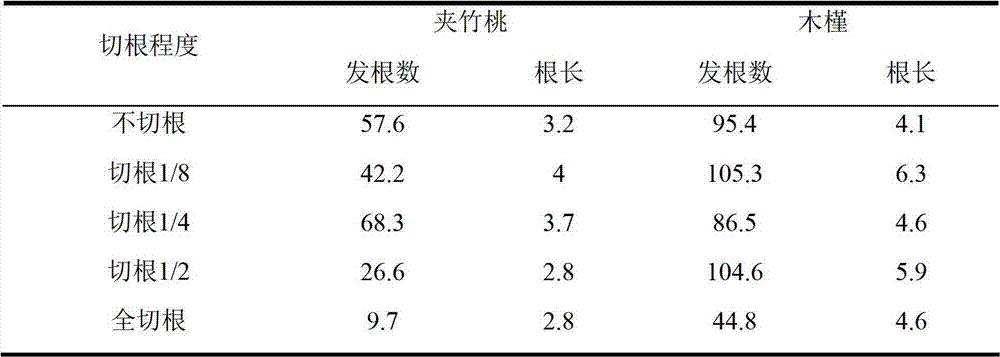Root system induction method of woody plants in subsurface flow constructed wetland environment
A technology for artificial wetlands and woody plants, applied in the field of ecological environment, can solve problems such as the withering of herbs, and achieve the effects of simple induction method, expanded screening range and strong adaptability
Active Publication Date: 2013-01-09
CENTRAL SOUTH UNIVERSITY OF FORESTRY AND TECHNOLOGY
View PDF2 Cites 7 Cited by
- Summary
- Abstract
- Description
- Claims
- Application Information
AI Technical Summary
Problems solved by technology
[0005] The present invention aims to overcome the problem that most of the herbaceous plants die in artificial wetlands in subtropical regions, and provides a root induction method for woody plants in the subsurface flow constructed wetland environment, so that the woody plants can adapt to the sub
Method used
the structure of the environmentally friendly knitted fabric provided by the present invention; figure 2 Flow chart of the yarn wrapping machine for environmentally friendly knitted fabrics and storage devices; image 3 Is the parameter map of the yarn covering machine
View moreImage
Smart Image Click on the blue labels to locate them in the text.
Smart ImageViewing Examples
Examples
Experimental program
Comparison scheme
Effect test
 Login to View More
Login to View More PUM
 Login to View More
Login to View More Abstract
The invention discloses a root system induction method of woody plants in a subsurface flow constructed wetland environment. According to the method, an optimal testing design is carried out on four factors which influence the number and length of a woody plant aquatic root system in a subsurface flow constructed wetland environment by using oleander and hibiscus woody plants as materials, and the optimized root system induction conditions are as follows: one fourth of the root of the oleander is cut, the concentration of hormone is 1,000mg/kg, the substrate is peat soil, and the aeration time is 8 hours a day; one eighth of the root of the hibiscus is cut, the concentration of hormone is 1,000mg/kg, the substrate is roseite, and the aeration time is 16 hours a day. By utilizing the method, the tissue structure of the woody plant root system can be changed, and the aquatic root system grows out to achieve the aim of strong adaptability to an aqueous environment, so that the problem that most herbaceous plants in the constructed wetland wither in winter can be solved, the plant screening range of the constructed wetland can be enlarged, the variety and sightseeing property of species can increased. Therefore, the method has well application prospect.
Description
technical field [0001] The invention belongs to the technical field of ecological environment, and in particular relates to a root induction method of woody plants in a subsurface flow artificial wetland environment. Background technique [0002] Subsurface flow constructed wetland is the most commonly used constructed wetland type at present. In the subsurface constructed wetland system, the sewage flows under the surface of the wetland bed. On the one hand, it can make full use of the biofilm growing on the surface of the filler, the rich root system, the surface soil and the interception of the filler to improve its treatment effect and capacity; On the other hand, because the water flows below the surface, it has the characteristics of good thermal insulation performance, little impact on the treatment effect by climate, and good sanitation conditions. [0003] At present, the subsurface constructed wetland plants for domestic sewage treatment are basically herbaceous p...
Claims
the structure of the environmentally friendly knitted fabric provided by the present invention; figure 2 Flow chart of the yarn wrapping machine for environmentally friendly knitted fabrics and storage devices; image 3 Is the parameter map of the yarn covering machine
Login to View More Application Information
Patent Timeline
 Login to View More
Login to View More IPC IPC(8): A01G7/06A01G31/00
Inventor 陈永华吴晓芙陈明利郝君柳俊
Owner CENTRAL SOUTH UNIVERSITY OF FORESTRY AND TECHNOLOGY
Features
- R&D
- Intellectual Property
- Life Sciences
- Materials
- Tech Scout
Why Patsnap Eureka
- Unparalleled Data Quality
- Higher Quality Content
- 60% Fewer Hallucinations
Social media
Patsnap Eureka Blog
Learn More Browse by: Latest US Patents, China's latest patents, Technical Efficacy Thesaurus, Application Domain, Technology Topic, Popular Technical Reports.
© 2025 PatSnap. All rights reserved.Legal|Privacy policy|Modern Slavery Act Transparency Statement|Sitemap|About US| Contact US: help@patsnap.com



